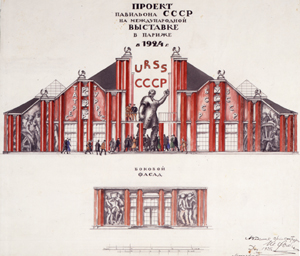 |
Fomin I.
USSR Pavilion for the Exposition des Arts Decoratifs`1925.Paris
1924
SSRMA
1) The USSR pavilion ought not to be similar to the pavilions of bourgeois countries. It also ought not to bear any resemblance to Russian buildings of the pre-revolutionary period. Bearing this in mind, I propose designing it in anew style, which will nonetheless not resort to affectation, nor the methods of ultrafuturistic approaches to architecture, which are both problematic to realise and present too great a challenge. I have seen to it that the principle stylisation of the pavilion reflects the character of the worker and peasant government of our country. Consequently, my architecture bears a somewhat utilitarian character and incorporates a combination of a decorative, exhibitive style with elements of factory construction, as is clear from the prospective sketch.
2) The composition’s centre is proposed as a large sculpted figure of a worker in a beckoning pose. All architectural forms from all sides are directed towards and concentrated upon this figure - symbolising the striving of all nationalities to join the worker’s call and come together as one in the USSR. For this central figure, I propose a sculpture already existing in the form of a clay model designed for the monument to Comrade Artem in the Don
Bass, but never constructed.
Serving the ideas embodied in the USSR, this exhibit simultaneously serves as a prime example of Russian decorative sculpture.
3) The walls of the pavilion, adorned with murals on the theme of workers’ and peasants’ lives could also take on the character of an exhibit. We possess a whole string of artists who could brilliantly show off their mastery of decorative art in fulfilling this task.
4) If, for any reason, the large figure of the Beckoning Worker proves to be unacceptable, then it could be scaled down. The facade modelled at a scale of 1/100 devoid of this figure, proves that the composition is nonetheless architecturally complete without it. It could be substituted by, for example, a large pole for flags and banners of all nationalities, united at its highest point by the Red Banner of the USSR.
|

